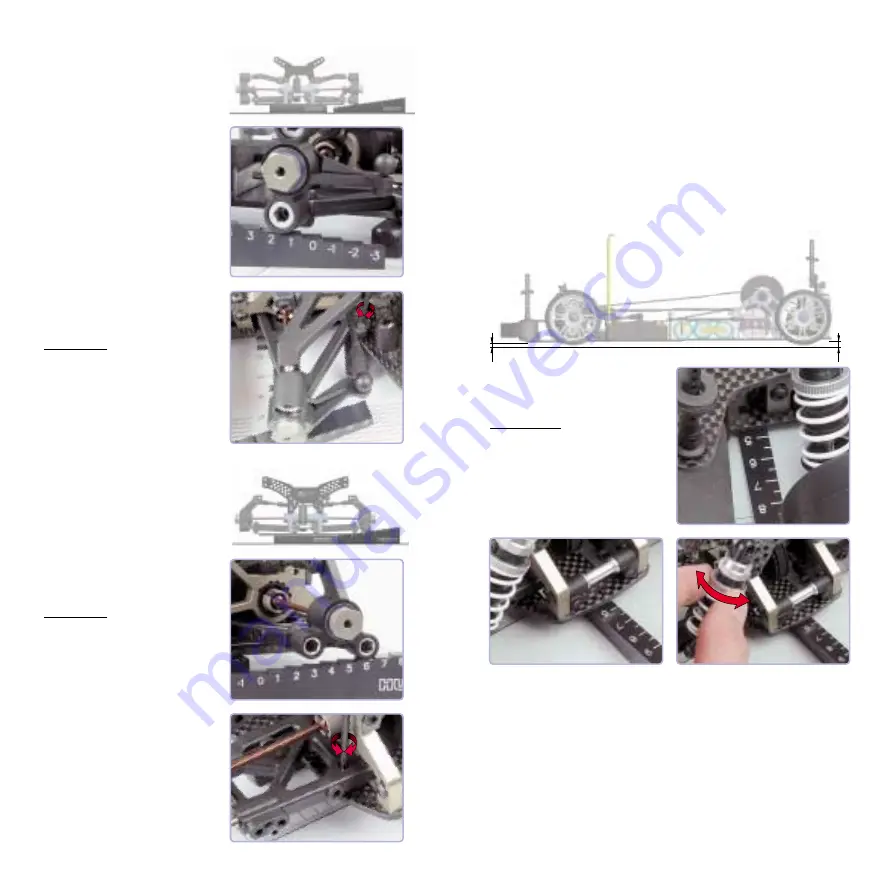
RIDE HEIGHT
This describes the height of the chassis in relation to the surface it is sitting
on. This adjustment must be made with the chassis ready-to-run but with no
body. The shock preload collars are used for raising and lowering the ride
height.
Perform these initial steps:
1. Prepare the car ready-to-run, without body.
2. Place the car on Hudy Set-up Board and use #10 7715 Ride Height
Gauge to measure the ride height in front and rear.
Use the shock preload collars to
raise or lower the ride height.
Initial settings:
Front ride height: 5mm
Rear ride height: 6mm
Try using a slightly lower ride height
for high traction conditions, such as
carpet racing.
A
AN
NT
TII--R
RO
OLLLL B
BA
AR
RS
S ((a
avva
aiilla
ab
blle
e o
op
pttiio
on
n))
Anti-roll bars are used to stabilize the car from excessive chassis roll (which
occurs when the car leans through the turns by centrifugal force).
Anti-roll bars are generally used on smooth, high traction track conditions. If
the conditions are very bumpy, then anti-roll bars are probably not necessary.
NOTE: Anti-roll bars adjustment is performed with disconnected shocks.
Chassis Set-up
F
Frro
on
ntt d
do
ow
wn
nsstto
op
pss::
Using the #10 7712 measuring
gauge, measure the distance from the
reference surface to the bottoms of the
steering blocks. Positive numbers
indicate the distance (in mm) ABOVE
the level of the support blocks (or,
above the bottom of the chassis).
Negative numbers indicate the
distance (in mm) BELOW the level of
the support blocks (or, below the
bottom of the chassis).
Adjust the front downstop screws so
that the bottoms of the steering
blocks are at the recommended
setting on the gauge.
Initial setting: 2 mm on gauge.
(Actual measurement = 2 mm above
the level of support blocks).
The downstops depends on the
diameter of tires and track condition.
The above setting was for smaller tires
(approx. 63 mm) and a smooth track.
R
Re
ea
arr d
do
ow
wn
nsstto
op
pss::
Adjust the rear downstop screws so
that the bottoms of the rear uprights
are at the recommended setting on
the gauge. Note that the REAR pivot
ball hole should be used for
downstop measuring.
Initial setting: 6mm on gauge.
(Actual measurement = 6mm above
the level of support blocks).
The downstops depends on the
diameter of tires and track condition.
The above setting was for smaller
tires (approx. 63 mm) and a smooth
track.
Also, if you have too much steering
while coming into corner off throttle
or while braking, try adding 1mm to
the rear downstop setting. This will
cut down on the amount of weight
that is transferred away from the rear
tires when off the throttle.
Chassis Set-up
RIDE HEIGHT FRONT
RIDE HEIGHT REAR
18
17
Summary of Contents for T1 EVO2
Page 1: ......




































